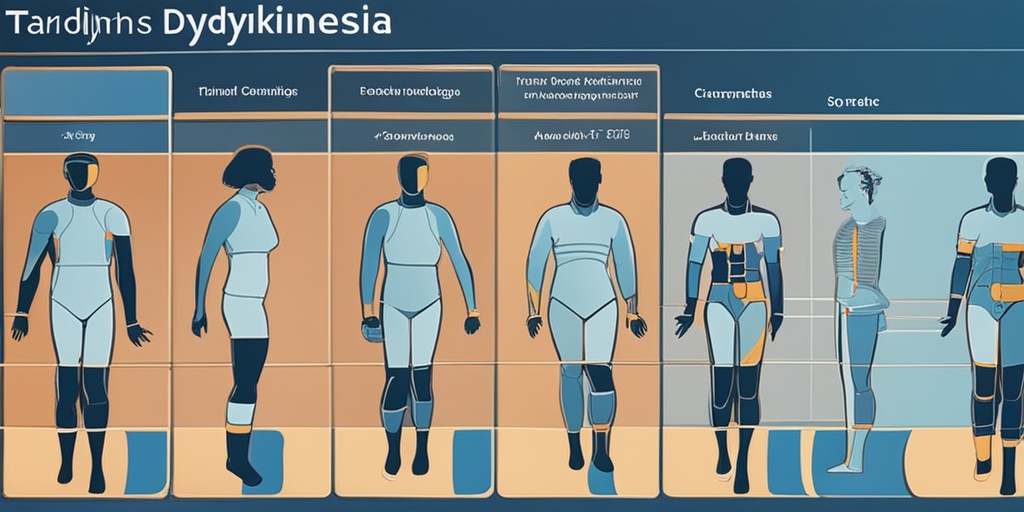“`html
What Is Tardive Dyskinesia?
Tardive Dyskinesia (TD) is a neurological disorder characterized by involuntary, repetitive movements, often affecting the face, tongue, and limbs. It is primarily associated with long-term use of certain medications, particularly antipsychotics, which are commonly prescribed for mental health conditions such as schizophrenia and bipolar disorder. The term “tardive” means “late,” indicating that these symptoms typically emerge after prolonged exposure to these medications.
Understanding the meaning of tardive dyskinesia is crucial for both patients and healthcare providers. While TD can be distressing and impact daily life, awareness and early intervention can significantly improve outcomes. If you or someone you know is experiencing symptoms, it’s essential to consult a healthcare professional for guidance.
Causes of Tardive Dyskinesia
The primary cause of tardive dyskinesia is the long-term use of dopamine receptor antagonists, which are found in many antipsychotic medications. These drugs work by blocking dopamine, a neurotransmitter that plays a key role in movement and coordination. Over time, this blockage can lead to changes in the brain that result in the involuntary movements characteristic of TD.
Other factors that may contribute to the development of TD include:
- Duration of medication use: The longer a person is on antipsychotic medication, the higher the risk of developing TD.
- Age: Older adults are more susceptible to TD, particularly women.
- Type of medication: Some antipsychotics are more likely to cause TD than others.
- Underlying health conditions: Individuals with certain neurological conditions may be at greater risk.
Tardive Dyskinesia Symptoms
The symptoms of tardive dyskinesia can vary widely among individuals, but they typically include:
- Facial movements: Involuntary grimacing, lip smacking, or tongue protrusion.
- Limbs and trunk: Jerking or twisting movements of the arms, legs, or torso.
- Difficulty with coordination: Challenges in performing everyday tasks due to involuntary movements.
- Changes in speech: Slurred or disrupted speech patterns due to facial muscle involvement.
Recognizing Symptoms Early
Early recognition of tardive dyskinesia symptoms is vital for effective management. If you notice any of the above symptoms, it’s important to discuss them with your healthcare provider. They may recommend adjusting your medication or exploring alternative treatment options.
Impact on Quality of Life
The involuntary movements associated with TD can significantly impact a person’s quality of life. Many individuals experience social anxiety, embarrassment, or depression due to their symptoms. It’s essential to address these emotional and psychological aspects alongside the physical symptoms. Support groups and therapy can be beneficial in managing the emotional toll of tardive dyskinesia.
Seeking Help and Treatment
While there is no definitive cure for tardive dyskinesia, several treatment options can help manage symptoms. These may include:
- Medication adjustments: Switching to a different antipsychotic or adjusting the dosage may alleviate symptoms.
- Medications specifically for TD: Certain medications, such as valbenazine and deutetrabenazine, have been approved to treat tardive dyskinesia.
- Therapeutic interventions: Occupational therapy and physical therapy can help improve coordination and manage symptoms.
For more information on managing tardive dyskinesia and finding evidence-based health answers, consider visiting Yesil Health AI. They provide valuable resources to help you navigate your health journey.
In conclusion, understanding tardive dyskinesia is essential for those affected by it. By recognizing the symptoms and seeking appropriate treatment, individuals can improve their quality of life and manage this challenging condition effectively. 🌟
“`

“`html
Tardive Dyskinesia Causes
Tardive Dyskinesia (TD) is a neurological disorder characterized by involuntary, repetitive body movements. Understanding the causes of tardive dyskinesia is crucial for both prevention and management. This condition is primarily associated with long-term use of certain medications, particularly antipsychotics.
Medications Linked to Tardive Dyskinesia
The most common medications that can lead to tardive dyskinesia include:
- Antipsychotics: These are the primary culprits, especially first-generation (typical) antipsychotics like haloperidol and chlorpromazine. Second-generation (atypical) antipsychotics, such as risperidone and olanzapine, can also cause TD, but the risk is generally lower.
- Antiemetics: Medications used to treat nausea and vomiting, such as metoclopramide, can also trigger tardive dyskinesia, especially when used for extended periods.
Mechanism of Action
The exact mechanism behind tardive dyskinesia is not fully understood, but it is believed to involve:
- Dopamine Receptor Sensitivity: Long-term use of dopamine-blocking agents can lead to changes in the brain’s dopamine receptors, making them more sensitive and resulting in abnormal movements.
- Neurotransmitter Imbalance: The disruption of neurotransmitter systems, particularly dopamine, serotonin, and GABA, may contribute to the development of TD.
Other Potential Causes
While medication is the primary cause, other factors may also contribute to the onset of tardive dyskinesia:
- Age: Older adults are at a higher risk of developing TD, possibly due to age-related changes in the brain.
- Gender: Women may be more susceptible to tardive dyskinesia than men, particularly post-menopausal women.
- Duration of Treatment: The longer a person is on antipsychotic medication, the greater the risk of developing TD.
Tardive Dyskinesia Risk Factors
Identifying the risk factors for tardive dyskinesia can help in early detection and management of the condition. While anyone taking certain medications can develop TD, some individuals are more vulnerable than others.
Key Risk Factors
- Long-term Use of Antipsychotics: Prolonged exposure to antipsychotic medications significantly increases the risk of developing tardive dyskinesia.
- Older Age: Individuals over the age of 50 are at a higher risk, as the brain’s ability to adapt to medication changes diminishes with age.
- Female Gender: Studies suggest that women, particularly those who are older or post-menopausal, have a higher incidence of TD.
- History of Movement Disorders: Those with a prior history of movement disorders, such as Parkinson’s disease or dystonia, may be more susceptible to developing tardive dyskinesia.
- High Doses of Medication: Taking higher doses of antipsychotic medications can elevate the risk of TD.
Psychiatric Conditions
Individuals with certain psychiatric conditions may also be at increased risk:
- Schizophrenia: Patients with schizophrenia often require long-term antipsychotic treatment, which can lead to TD.
- Bipolar Disorder: Similar to schizophrenia, those with bipolar disorder may be prescribed antipsychotics for mood stabilization.
Other Considerations
In addition to the above factors, lifestyle and health conditions can also play a role in the risk of developing tardive dyskinesia:
- Substance Abuse: The use of drugs or alcohol can complicate treatment and increase the risk of movement disorders.
- Neurological Conditions: Pre-existing neurological disorders may predispose individuals to TD.
Understanding the causes and risk factors associated with tardive dyskinesia is essential for effective management and prevention strategies. If you or someone you know is taking medications that may lead to TD, it’s important to discuss any concerns with a healthcare provider. 🩺
“`

“`html
Tardive Dyskinesia Diagnosis
Tardive Dyskinesia (TD) is a complex condition that can significantly impact a person’s quality of life. Diagnosing TD can be challenging due to its subtle symptoms and the need for a thorough understanding of the patient’s medical history. Here, we will explore the diagnostic process for Tardive Dyskinesia, including the symptoms to watch for and the tests that may be conducted.
Recognizing the Symptoms
The first step in diagnosing Tardive Dyskinesia is recognizing its symptoms. Common symptoms include:
- Involuntary Movements: These may include repetitive movements of the face, tongue, and limbs.
- Facial Grimacing: Patients may exhibit unusual facial expressions.
- Difficulty with Coordination: Some individuals may struggle with fine motor skills.
- Changes in Speech: Slurred or slow speech can also be a symptom.
These symptoms often develop after long-term use of antipsychotic medications, which are commonly prescribed for conditions like schizophrenia and bipolar disorder. If you or someone you know is experiencing these symptoms, it’s crucial to consult a healthcare professional.
Medical History and Physical Examination
During the diagnosis of Tardive Dyskinesia, a healthcare provider will conduct a comprehensive medical history review. This includes:
- Medication Review: Discussing any medications taken, especially antipsychotics.
- Symptom Timeline: Noting when symptoms began in relation to medication use.
A physical examination will also be performed to assess the nature and severity of the involuntary movements. This examination helps differentiate TD from other movement disorders, such as dystonia.
Diagnostic Tests
While there is no specific test for Tardive Dyskinesia, healthcare providers may use various diagnostic tools to rule out other conditions:
- Neurological Examination: This may include tests to evaluate coordination, reflexes, and muscle strength.
- Imaging Tests: MRI or CT scans can help rule out other neurological disorders.
Ultimately, the diagnosis of Tardive Dyskinesia is made based on clinical evaluation and the exclusion of other potential causes of the symptoms. Early diagnosis is crucial for effective management of the condition.
Tardive Dyskinesia Treatment Options
Once diagnosed, managing Tardive Dyskinesia involves a multifaceted approach tailored to the individual’s needs. Treatment options can vary widely, depending on the severity of symptoms and the patient’s overall health. Here are some of the most common treatment strategies:
Medication Adjustments
One of the first steps in treating Tardive Dyskinesia is often adjusting the medications that may have contributed to the condition. This can include:
- Reducing Dosage: Lowering the dose of the antipsychotic medication may alleviate symptoms.
- Switching Medications: In some cases, switching to a different class of medication can be beneficial.
Medications Specifically for Tardive Dyskinesia
Several medications have been approved specifically for the treatment of Tardive Dyskinesia. These include:
- Valbenazine (Ingrezza): This medication helps reduce involuntary movements associated with TD.
- Deutetrabenazine (Austedo): Another option that can help manage symptoms effectively.
These medications work by targeting the neurotransmitters in the brain that are involved in movement control, helping to reduce the severity of symptoms.
Therapeutic Approaches
In addition to medication, various therapeutic approaches can be beneficial:
- Physical Therapy: This can help improve coordination and reduce the impact of involuntary movements.
- Occupational Therapy: Focuses on helping individuals manage daily activities more effectively.
- Support Groups: Connecting with others who have TD can provide emotional support and coping strategies.
It’s essential for individuals with Tardive Dyskinesia to work closely with their healthcare providers to develop a comprehensive treatment plan that addresses their unique needs. With the right approach, many people can manage their symptoms and improve their quality of life. 🌟
“`

“`html
Tardive Dyskinesia Management Strategies
Tardive Dyskinesia (TD) is a neurological disorder characterized by involuntary, repetitive body movements, often as a side effect of long-term use of certain medications, particularly antipsychotics. Managing this condition can be challenging, but with the right strategies, individuals can improve their quality of life. Here are some effective management strategies for Tardive Dyskinesia:
1. Medication Adjustments
One of the first steps in managing Tardive Dyskinesia is to consult with a healthcare provider about medication adjustments. This may involve:
- Reducing the dosage of the current medication
- Switching to a different antipsychotic with a lower risk of TD
- Discontinuing the use of the offending medication, if possible
It’s crucial to work closely with a healthcare professional to ensure that any changes are safe and appropriate.
2. Use of Medications Specifically for TD
There are medications specifically designed to help manage Tardive Dyskinesia symptoms. These include:
- Valbenazine (Ingrezza): Approved for the treatment of TD, it works by reducing the abnormal movements.
- Deutetrabenazine (Austedo): Another option that helps manage involuntary movements associated with TD.
Discussing these options with a healthcare provider can help determine the best course of action.
3. Behavioral Therapies
In addition to medication, behavioral therapies can play a significant role in managing Tardive Dyskinesia. These therapies may include:
- Cognitive Behavioral Therapy (CBT): Helps individuals cope with the emotional aspects of living with TD.
- Occupational Therapy: Assists in developing strategies to manage daily activities despite the symptoms.
Engaging in these therapies can provide valuable coping mechanisms and support.
4. Lifestyle Modifications
Making certain lifestyle changes can also help manage Tardive Dyskinesia symptoms. Consider the following:
- Regular Exercise: Physical activity can improve overall well-being and may help reduce symptoms.
- Healthy Diet: A balanced diet rich in antioxidants and omega-3 fatty acids can support brain health.
- Stress Management: Techniques such as yoga, meditation, and deep breathing can help reduce stress, which may exacerbate symptoms.
5. Support Groups and Resources
Connecting with others who understand the challenges of Tardive Dyskinesia can be incredibly beneficial. Support groups provide a platform for sharing experiences, tips, and emotional support. Online forums and local community groups can be excellent resources for finding such support.
Tardive Dyskinesia Outlook and Prognosis
The outlook for individuals diagnosed with Tardive Dyskinesia can vary significantly based on several factors, including the severity of symptoms, the duration of medication use, and the effectiveness of management strategies. Understanding the prognosis is essential for patients and their families.
1. Variability of Symptoms
Tardive Dyskinesia symptoms can range from mild to severe. Some individuals may experience only minor involuntary movements, while others may have more pronounced symptoms that significantly impact daily life. The variability of symptoms means that each person’s experience with TD is unique.
2. Potential for Improvement
Many individuals with Tardive Dyskinesia can see improvement in their symptoms with appropriate management strategies. Early intervention, including medication adjustments and behavioral therapies, can lead to better outcomes. In some cases, symptoms may diminish or resolve entirely after discontinuing the offending medication.
3. Long-Term Considerations
While some individuals may experience a complete resolution of symptoms, others may have persistent involuntary movements. Long-term management is often necessary, and ongoing communication with healthcare providers is crucial. Regular follow-ups can help monitor symptoms and adjust treatment plans as needed.
4. Importance of Awareness
Raising awareness about Tardive Dyskinesia is vital for improving the prognosis for those affected. Increased understanding among healthcare providers can lead to earlier diagnosis and more effective management strategies. Education about the condition can empower patients and their families to advocate for appropriate care.
In conclusion, while Tardive Dyskinesia presents challenges, effective management strategies and a supportive outlook can significantly enhance the quality of life for those affected. With the right approach, individuals can navigate their journey with TD more confidently. 🌟
“`

“`html
Frequently Asked Questions about Tardive Dyskinesia
What is Tardive Dyskinesia?
Tardive Dyskinesia is a neurological disorder characterized by involuntary, repetitive movements, often affecting the face, tongue, and limbs. It is typically a side effect of long-term use of certain medications, particularly antipsychotics.
What are the symptoms of Tardive Dyskinesia?
Common symptoms include:
- Involuntary facial movements, such as grimacing or lip smacking
- Jerky movements of the arms and legs
- Difficulty with speech
- Abnormal posture
What causes Tardive Dyskinesia?
The primary cause of Tardive Dyskinesia is the prolonged use of certain medications, especially antipsychotics. Other factors may include:
- Duration of medication use
- Dosage of the medication
- Individual susceptibility
Is Tardive Dyskinesia a side effect of specific medications?
Yes, Tardive Dyskinesia is most commonly associated with antipsychotic medications, particularly first-generation antipsychotics. However, it can also occur with some second-generation antipsychotics and other medications.
How is Tardive Dyskinesia treated?
Treatment options for Tardive Dyskinesia may include:
- Adjusting or discontinuing the medication causing the symptoms
- Medications specifically approved for managing Tardive Dyskinesia
- Therapies to help manage symptoms
What is the ICD-10 code for Tardive Dyskinesia?
The ICD-10 code for Tardive Dyskinesia is F32.81. This code is used for medical billing and documentation purposes.
How does Tardive Dyskinesia differ from Dystonia?
While both conditions involve involuntary movements, Tardive Dyskinesia is characterized by repetitive, jerky movements, whereas dystonia involves sustained muscle contractions and abnormal postures. Understanding the differences can aid in proper diagnosis and treatment.
Where can I find more information about Tardive Dyskinesia?
For more detailed information, consider consulting healthcare professionals or reputable medical websites. You can also find educational videos that explain Tardive Dyskinesia and its management.
“`




